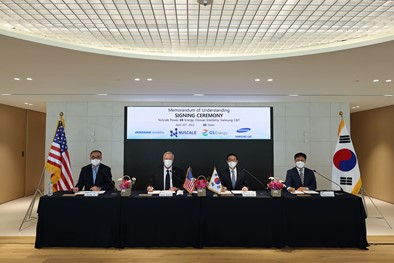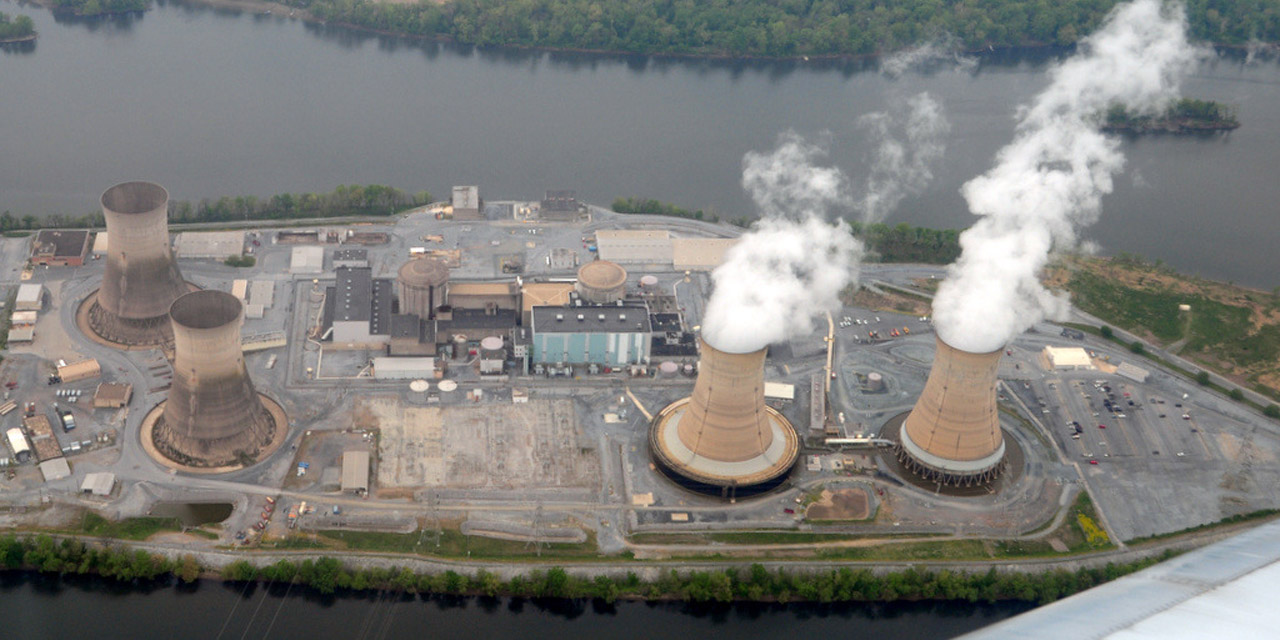The nuclear power plant in Cattenom, France. (Photo: Stefan Kühn)
Bloomberg recently reported that nuclear power production in France declined to its lowest level in almost two years in April, with power output during that month falling to 21.7 TWh. The decline occurred as Électricité de France (EDF), one of the country’s major energy suppliers, dealt with long-term inspection-and maintenance-related halts to the operation of many of its 56 domestic nuclear reactors.
An artist’s rendering of the Hanhikivi plant. (Image: Rosatom)
Finnish energy company Fennovoima has terminated, effective immediately, its engineering, procurement, and construction (EPC) contract with RAOS Project Oy, a subsidiary of Russia’s Rosatom, for the delivery of a 1,200-MWe VVER-1200 pressurized water reactor at the Hanhikivi site in Finland’s Pyhäjoki municipality.
A pair of Westinghouse AP1000 reactors at China's Haiyang nuclear power plant.
China’s State Council recently approved the construction of four Westinghouse AP1000 reactors—two at China’s Sanmen plant in Zhejiang Province and two at the Haiyang plant in Shandong Province.
The plants currently house two AP1000 units each. Sanmen’s reactors are rated at 1,157 MWe and Haiyang’s at 1,170 MWe. Sanmen-1 and -2 began commercial operation in 2018. Haiyang-1 started commercial operation in 2018, and Haiyang-2 in 2019.
Alkali-silica reaction was confirmed at the Seabrook nuclear power plant in 2010. (Photo: NextEra Energy Resources)
Concrete structures built to last for decades, including reactor containment buildings and other nuclear power plant structures, are subject to the alkali-silica reaction (ASR), a reaction between alkali ions found in cement and silica, the two main components of concrete. The reaction forms a gel that absorbs water and expands over time, causing a buildup of pressure within the concrete that can eventually lead to cracking and deterioration.
Researchers at Argonne National Laboratory have successfully used electrochemical impedance spectroscopy (EIS) to detect ASR in the lab and believe it could be used for cost-effective, nondestructive testing at nuclear power plants.
Purdue University, in West Lafayette, Ind.
Purdue University and Duke Energy have announced that they plan to jointly explore the feasibility of using advanced nuclear energy to meet the university’s long-term energy needs, “a move that may be unprecedented for a college campus.” A small modular reactor could meet the current and future needs for Purdue’s West Lafayette, Ind., campus, as well as provide excess power to the state’s electric grid, according to a joint press release.
Annie Caputo (left) and Bradley R. Crowell
An aerial view of the Facility for Rare Isotope Beams on the Michigan State University campus in East Lansing, Mich. (Photo: FRIB)
Michigan State University’s Facility for Rare Isotope Beams (FRIB) officially opened yesterday with a ribbon-cutting ceremony attended by Energy Secretary Jennifer Granholm, elected officials, and guests who had supported the project during its planning and construction, including ANS Executive Director/Chief Executive Officer Craig Piercy. They were there to celebrate the completion—on time and within budget—of the world’s most powerful heavy-ion accelerator and the first accelerator-based Department of Energy Office of Science user facility located on a university campus.
Diablo Canyon nuclear power plant
California Gov. Gavin Newsom told the Los Angeles Times editorial board last week that his administration would look into using the federal government’s Civil Nuclear Credit Program to keep Pacific Gas and Electric Company’s Diablo Canyon nuclear plant in operation beyond its scheduled 2025 closure date.
“The requirement is by May 19 to submit an application, or you miss the opportunity to draw down any federal funds if you want to extend the life of that plant,” Newsom told the board, according to an April 29 LA Times piece. “We would be remiss not to put that on the table as an option.”
Kiyoun Na, chief executive officer of Doosan Enerbility’s nuclear business group; John Hopkins, president and CEO of NuScale Power; Yongsoo Huh, president and CEO of GS Energy; and Byung Soo Lee, executive vice president of Samsung C&T, signed an MOU to collaborate on NuScale SMR deployment in Asia.
Small modular reactor developer NuScale Power has signed a memorandum of understanding with three South Korean companies—Doosan Enerbility Company, GS Energy Corporation, and Samsung C&T Corporation—to explore the deployment of NuScale’s VOYGR power plants in Asia.
Sparked by an article on the TMI accident that appeared in the March 2019 issue of Nuclear News, ANS past president William E. Burchill (2008–2009) offered his own views on the subject. Part 1 of the article appeared in the May 2019 issue of NN and Part 2 was published in June 2019.
The accident at Unit 2 of the Three Mile Island nuclear power plant on March 28, 1979, was an extremely complex event. It was produced by numerous preexisting plant conditions, many systemic issues in the industry and the Nuclear Regulatory Commission, unanticipated operator actions, previously unrecognized thermal-hydraulic phenomena in the reactor coolant system (RCS), and the unprecedented challenge of managing a severely degraded core.
Ukraine’s president, Volodymyr Zelensky, thanks IAEA director general Rafael Mariano Grossi for the agency’s support, including its April 26 mission to Chernobyl. (Photo: IAEA)
The director general of the International Atomic Energy Agency, Rafael Mariano Grossi, led a mission to Ukraine’s Chernobyl nuclear plant this week to address ongoing radiological safety concerns at the shuttered site following five weeks (February 24–March 31) of Russian military occupation.
Mark Brzezinski, U.S. ambassador to Poland, and John Howanitz, president of Bechtel’s nuclear, security, and environmental global business unit, address representatives of 12 Polish companies that signed memorandums of understanding with Bechtel for the potential development of Poland’s civil nuclear program. (Photo: Bechtel)
Bechtel has signed memorandums of understanding with a dozen Polish companies for the potential development of two nuclear power plants as Poland seeks to lessen its dependence on domestic coal and Russian imports for its energy supply.
The MOUs were signed on April 25 during a ceremony at the U.S. ambassador’s residence in Warsaw. Offering services ranging from earthwork and infrastructure construction to concrete, tunneling, electrical installations, and heavy cranes, the 12 Polish firms are BAKS, Budimex, Doraco, Energoprojekt-Katowice, Hitachi Energy Poland, ILF, KB Pomorze, Mostostal Warzsawa, Polimex Mostostal, Protea Group, Vistal Gdynia, and Zarmen.

















